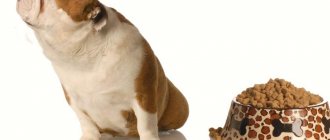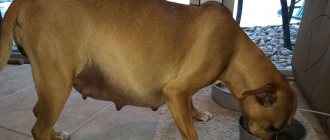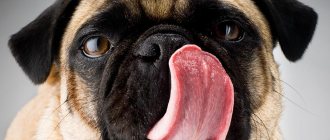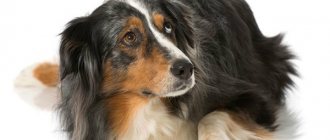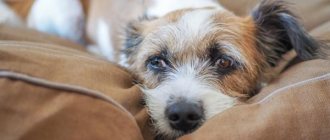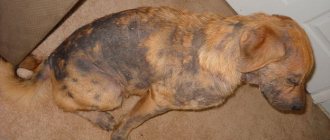For every owner, the health of their pet is a top priority. Therefore, if a dog refuses to eat, this is always a cause for concern. There is no need to panic right away, but it is recommended to pay close attention to your pet. There are many reasons for this phenomenon, so you need to carefully analyze all the symptoms and draw the right conclusions.
If your pet remains active
In this case, we can say that everything is not so bad, but you should not lose your vigilance. The fact is that the need for food is leading. Therefore, even if the animal does not feel hungry, it will not refuse food, especially treats. There must be compelling reasons for this. So let's look at why a dog refuses to eat?
- If a puppy, as it grows up, begins to refuse one of its meals, then there is nothing to worry about. It’s just that now he no longer needs additional feeding.
- If an animal plays and frolics, but often turns away from the cup, this may mean that it is simply picky and expects more tasty pieces from its owner.
- If there was serious physical activity in the evening, then do not be surprised that the dog refuses to eat in the morning.
- It is not uncommon for a female dog in heat to ignore the bowl. If you have a male living with you, and on a walk he meets a female in heat, the reaction will be similar. These are hormones and nothing more.
- The next reason could be stress. If the owner left the animal in the kennel and went on a business trip, then in almost 100% of cases the dog refuses to eat. For the first few days she won’t even drink water, but with a good attitude she will soon calm down.
Causes of decreased appetite
Some factors may cause a pet to refuse food, but are not pathological and do not require an urgent call to the veterinarian. Perhaps the dog is simply hot - if it’s a sunny day outside or stuffy indoors. The fact that a pet is experiencing discomfort can be judged by increased thirst and decreased activity. The dog sticks out its tongue and breathes faster than usual. Provide her with clean, cool water in sufficient quantities, try to provide comfortable conditions - ventilate the room, turn on the fan, open the window slightly.
Another natural cause of decreased appetite is improper feeding. If a dog constantly has unlimited food in his bowl, the pet can eat several times a day, and it is not surprising that at the appointed feeding time he will refuse food because he is full.
The dog will not eat stale food either. This is especially true in the summer, when the days are hot, so you should prepare your pet’s food directly for one feeding and not leave food in a bowl. Pets are also sensitive to low-quality food, so if you want your pet to be healthy and develop correctly, it is important to choose only high-quality food for it.
If the cause of decreased appetite is not illness, you can normalize it by following simple rules:
- provide your pet with comfortable living conditions, maintain normal air temperature and humidity in the room;
- Make sure your dog always has clean, fresh water in his bowl. In hot weather, all animals eat little, but drink a lot;
- do not disrupt the diet, do not leave food in the bowl after feeding. This way you can spoil the dog, which will get used to constantly available food;
- feed only fresh, high-quality food. This rule applies to both industrial feed and natural food.
Important!
An adult dog needs to be fed twice a day. She may refuse to eat during feedings if you pamper her with tasty treats in between. This is how the dog develops an instinct: why eat everything that is in the bowl.
A likely cause of poor appetite may be incorrect portion calculation. This primarily applies to cases where the dog is fed dry industrial food. During the growth period, animals require more nutrients, which are spent not only on providing the body with energy, but also on the formation of tissues and organs. When a dog gains the body weight required for its breed, it needs nutritional adjustments.
Important!
The standards indicated on the food package are advisory in nature, so you should monitor your pet, its behavior and activity. If your dog often has food left in his bowl, you should reduce the portion.
With a mixed diet (alternating industrial dry food with natural food), it is even more difficult to calculate the required volume of food so that it is also balanced. For ready-made food, which contains all the nutrients, vitamins and minerals your pet needs, and natural food, which requires the use of nutritional supplements, it will be different. Therefore, it is not surprising that the dog eats with appetite one time, and leaves the food in the bowl at another feeding. Therefore, it is advisable to choose one type of feeding and stick to it.
The pet's appetite will also depend on strict adherence to the schedule of walks and feedings. This helps the body produce the required amount of gastric juice by a certain time. After a walk, the dog feels hungry and eats the food offered with appetite, which is well absorbed by the body.
Important!
Provide your dog with adequate physical activity appropriate for its age, breed, and health status, and your pet will have a good appetite.
Warning signs
Usually the owner knows his pet well. It’s one thing if he happily jumps around you, droplets of moisture glisten on his black nose, his eyes shine, but, having poked his head into the cup, the animal begins to look for tastier pieces. Including persistently asking you for cookies or a sandwich. In this case, we can safely say that everything is fine with him.
The situation is completely different if the dog didn’t come to wake you up in the morning. Hand her a piece of treat. If she reaches out to it, remembering that it is her favorite food, but turns away at the last moment, you need to immediately run to the veterinarian. This means that something bad is happening in the body. Most likely, this is a powerful intoxication. The animal wants to eat, but nausea does not allow it to swallow a piece. If you wait a little longer, the dog will weaken so much that it will no longer respond to any food.
If a puppy refuses to eat
Samoyed dog: why is this husky called that?
Loss of appetite during pregnancy is not such a rare or even typical phenomenon. In the first days, the bitch may burp frequently and become lethargic. Taste preferences change, and the dog refuses its usual, previously favorite food. A similar condition is observed immediately before childbirth. Although the vomiting should have stopped by this point, it becomes difficult for the pet to move, it will be apathetic, and prefers to sleep a lot.
After giving birth, the female also has no time to eat. If the dog does not eat and is lethargic, drinks and lies down, with a cold nose in the first 9 hours after the puppies appear, everything is fine. You should worry if the bitch does not touch food for a long time, more than a day.
If your dog has no appetite in the first weeks of pregnancy, this is absolutely normal.
What to do
It is very important to stay at home and watch your pets. Then you can definitely say that the dog is refusing to eat. The reasons must be sought together with the attending physician. To do this, a specialist must examine the dog and take the necessary tests. If there is a suspicion of the presence of a foreign body in the intestine, then a referral for an ultrasound or x-ray is given.
You should go to the veterinary clinic a maximum of 36 hours after an adult dog refuses to eat, and 48 hours for a puppy. If you contact us quickly, it will only be better.
When to worry
Refusal to eat, lethargy and apathy are signs of many diseases. On hot summer days, dogs often overheat in the sun and suffer heatstroke. Hypothermia is no less dangerous. It usually affects dogs of small breeds and animals without fur. In cold, drafty conditions, you may notice that the dog is shaking. Other signs of hypothermia:
- body temperature below +37.5 °C;
- shiver;
- slow breathing;
- convulsions;
- slowing heart rate.
Gastrointestinal pathologies
A dog may be lethargic due to various diseases of the gastrointestinal tract. They are often accompanied by pain and cramps in the abdomen, vomiting, and diarrhea. Eating aggravates the painful condition, provokes a new attack of pain, so the dog tries to move less and refuses to eat. Only a veterinarian can make a diagnosis after examination and a series of examinations. A depressed state and loss of appetite are a reason to contact a veterinary clinic.
Poisoning may have the same symptoms as gastrointestinal diseases. Intoxication can be caused by poor-quality food, medications and toxic substances (rat poison, for example), household chemicals, etc. Yellowing of the eyeballs and dry skin should cause alarm. Poisoning is usually accompanied by an increase in body temperature. Refusal to eat is the first sign of intoxication, which requires contacting a veterinarian.
Viral infections
Another reason why you cannot ignore the behavior of a dog that refuses to eat and lies on the bedding all day is the danger of contracting viral infections. Distemper, viral enteritis and other diseases that can lead to death must be treated immediately. Without qualified medical care, puppies die in 90% of cases.
Other signs that may indicate a viral infectious disease are:
- with distemper - photophobia, fever, ulceration of the mucous membranes, purulent discharge from the eyes, difficulty breathing;
- with parvovirus enteritis - vomiting, loose stools with blood, increased thirst;
- with adenovirus – redness of the mucous membranes, dry cough and wheezing, runny nose, vomiting;
- with viral hepatitis - increased body temperature, severe thirst, diarrhea and vomiting, yellowing of the skin and mucous membranes, keratitis and conjunctivitis.
Important!
In case of infectious diseases, if a pet refuses food and water, dehydration quickly occurs. It can cause the death of the animal.
Recording data
Your veterinarian will take a medical history to determine the cause. The dog refuses to eat for a reason, so your task is to reveal the situation in detail so that it is easier for the doctor to assess it:
- It is very important to record the time interval from your last meal.
- Try offering different foods so that the doctor knows for sure whether the animal is refusing something specific or everything.
- It is important to record the dog's ability to swallow food. To do this, while the condition is just beginning to worsen, offer your favorite treat. Even a seriously ill animal will often swallow it through force. If this does not happen, then tell your doctor.
- Constantly offer water and observe the result: drinks greedily, refuses.
- Pay attention to the dog's feces. Everything will be important, the change in shape, color, smell.
- If vomiting is observed, be sure to record its frequency, contents, and color of the discharge.
All this information will become very important in order to understand why the dog refuses to eat.
The dog refuses to eat - causes of anorexia
The dog's appetite appears in the intervals between feedings. The urge to feed is enhanced by the feeling of hunger. Reflexes, both innate and acquired during ontogenesis, play a huge role in the development of appetite. The food reflex can develop spontaneously (its appearance is influenced by the aroma of the food, consistency, ambient sounds and other factors) or developed as a result of training. The quality of appetite is influenced by many factors:
- blockage of the upper gastrointestinal tract;
- diseases of the oral cavity (broken teeth, gingivitis, stomatitis);
- general fatigue, feverish process;
- stress (transportation, change of environment);
- increased ambient temperature;
- low quality feed.
The process of food intake in dogs is regulated by various mechanisms, including the central nervous system, mechanical stimulation, humoral and metabolic processes. Changes in the volume of the stomach and the release of certain hormones (insulin) lead to changes in sensations of hunger and satiety. The central role in the regulation of digestion is played by the hypothalamus, stimulation of the lateral nuclei of which provokes a food reaction - the search for food, the production of digestive juices. Dulling of appetite occurs when the level of glucose in the blood increases, and when it decreases, a feeling of hunger occurs. Fatty acids have a similar effect - a decrease in fat reserves leads to an increase in their metabolic products, which again increases appetite.
There is a decrease in the dog's interest in food when the walls of the stomach and intestines are stretched. These organs contain mechanical receptors, which, when pressed, produce signals sent to the brain. Therefore, a puppy may refuse to feed if there is increased pressure on the stomach caused by tumors, accumulation of exudate, or intestinal blockage.
The severity of a dog's appetite is determined by various factors. The quality of food is important. Animals eat large quantities of only food that is pleasant to them and refuse spoiled or poorly prepared food. Dogs gradually develop a certain taste preference, so they try to consume a certain type of food.
A dog may refuse food if there is a sudden change in diet.
There is a decrease in appetite after intense exercise. Classes with pets in special areas, training them in training, training hounds, daily hunting lead to a temporary decrease in the animal’s interest in food. This is a short-term sign - after a short rest, the pet begins to eat food, and the appetite may increase.
The disappearance of hunger in dogs is called anorexia. The animal loses interest in food or shows little interest. Loss of appetite can be partial or complete, which reflects the severity of the development of the pathology, the symptom of which is anorexia. There are several mechanisms for the development of anorexia - suppression of appetite, suppression of the hunger center or stimulation of the satiety center. A variety of diseases can lead to this.
True anorexia is caused by pathologies affecting the food centers in the hypothalamus, which leads to eating disorders in the dog. More often one can observe psychological behavioral disorders due to nervous stress and poor-quality food. Less commonly in dogs, loss of appetite is associated with brain damage - edema, increased intracranial pressure, tumors, encephalitis.
Secondary anorexia is the result of an indirect effect on the feeling of hunger due to systemic pathologies that cause endocrine and nervous disorders. There are many primary reasons why dogs refuse food:
- pain of various origins;
- inflammatory processes;
- after childbirth there is a decrease in appetite;
- It is common for puppies to neglect food during the teething period;
- infectious diseases;
- poisoning by poisons, drugs, metabolic products;
- neoplasms;
- various metabolic disorders.
Anorexia associated with difficulty in eating and chewing food is false. In dogs with jaw fractures, esophageal obstruction, or injuries to the oral cavity, the feeling of hunger remains, and appetite is often increased. But due to pain, it is difficult to eat food and it seems that the dog is refusing food.
What could cause the refusal?
An experienced veterinarian regularly encounters similar problems, and therefore has a number of assumptions that remain to be checked and, by process of elimination, to find what is suitable in your case. If the picture does not fit into any of them, then these reasons will be excluded immediately. It can be:
- Dental problems. If the teeth are damaged or broken, the animal will experience severe pain.
- Gastrointestinal diseases.
- Liver disease.
- Poisoning.
- Viral and infectious diseases.
Each of these reasons requires immediate medical attention and treatment.
What else can be attributed to the reasons?
Why does a dog refuse to eat? If the tests are normal, vaccinations were given in a timely manner, and the pet categorically refuses food, then pay attention to what you have been feeding him recently. In addition to behavioral and medical problems, there are others:
- poor quality food;
- taking medications.
That is, refusing to eat can say a lot. Monitor your dog and contact your veterinarian promptly. This is the only way you can save him from a variety of problems.
Other reasons
Refusal to eat and the pet’s depressed state are also typical for other diseases. Diseases of muscles, bones, joints, and blood diseases are accompanied by pain. Pain occurs when moving, hence the unsteady gait and lethargy.
Injuries can damage internal organs. Internal bleeding threatens the dog’s life, but it is impossible to detect it visually. If your pet has a fever, is shaking, is vomiting, and there is blood in the vomit, contact your veterinarian immediately. And the best thing is to call a doctor at home, since during transportation there is a risk of further aggravating the problem.
With helminthiasis, a dog may experience bloating and bloody clots in the stool. The weakness and lethargy of the dog is explained by intoxication of the body - worms poison it with the products of their vital activity. Therefore, the pet is sad and refuses its favorite games and treats.
If your pet not only eats poorly and tries to lie down more, but at the same time he suddenly loses weight, it is worth checking him for cancer. In recent years, cancer has often been diagnosed not only in older animals, but also in young ones. The prognosis for the development of the disease and the quality of life of the animal depends on how quickly the diagnosis is made.
The dog is not eating well and has become lethargic
Of course, climate disasters may be the cause. Animals often lose their appetite when the weather is too hot. If it's the middle of summer, then it's quite possible that this is the reason. Try to provide the animal with rest during the day, and in the evening offer a bowl with a fresh portion again.
But much more often, if a dog is lethargic and refuses to eat, this indicates health problems. If this has not been noticed in your pet before, then this is a very serious symptom for which you should not hesitate to contact a veterinarian. Lethargy, drowsiness and refusal to feed are the first symptoms of enteritis or hepatitis.
Liver failure
The pathology includes several types: acute hepatic dystrophy, chronic liver failure, portacaval shunting.
In acute hepatic dystrophy, generalized damage to the liver tissue occurs, which occurs as a result of exposure to infections and toxins.
With hepatic dystrophy, damage to the liver tissue occurs.
Chronic liver failure is characterized by slow development, but the provoking factors are the same as in the first case.
Portoqual shunting is extremely rare, but this does not diminish the danger of this pathology. In the presence of the disease, vascular anastomoses form, through which blood flows directly into the general bloodstream.
Clinical signs and causes of liver failure
As for the causes of this disease, there are quite a lot of them. The influence is exerted by toxins, parasitic infections, and viruses. Feeding spoiled foods, eating disorders, poisoning.
Progressive diarrhea may alternate with constipation.
- The first sign is severe oppression of the animal.
- The dog refuses food, even treats.
- Constantly lies down, does not react to the owner, does not respond and does not make contact.
- In some cases, there is increased thirst, but this symptom occurs only at the beginning of the disease, then the dog stops drinking water.
- The development of intoxication provokes vomiting.
- The skin turns yellow, becomes dry, parchment-like, the coat becomes dull and takes on a sloppy appearance.
- Diarrhea progresses, which may alternate with constipation.
- The feces take on a light color, sometimes almost white.
- The urine becomes a deep orange color.
- It is worth noting that the appearance and variability of symptoms will depend on the provoking factor.
- If there is a parasitic infection, the skin and mucous membranes quickly turn yellow.
- With toxic damage, jaundice may be completely absent.
- Regardless of the cause, ascites - water in the abdominal cavity - will always be present.
- In severe cases, symptoms of nervous pathology occur - seizures, paralysis or paresis of limbs, convulsions.
Only a veterinarian can make an accurate diagnosis and find out the cause of the symptoms. Diagnosis is carried out in a hospital setting. The doctor does a biochemical blood test and a biopsy of liver tissue. Feces and urine are examined.
Therapy
Treatment should begin based on the cause of the occurrence, why the liver’s normal functioning decreases or even stops.
The veterinarian's main job is to eliminate symptoms.
- Portocaval shunting requires a surgical approach to treatment.
- The rehabilitation period after surgery spends the first days in the clinic, under the strict supervision of a doctor.
- Opisthorchiasis is eliminated by means that are directly destructive to the worm - hexachloro-paraxylene. In this case, a special diet is used to reduce the load on the liver and medications are prescribed to help this organ recover.
- The main task of the doctor is to eliminate the symptoms and apply narrowly targeted means to eliminate the primary pathology. Next, maintenance therapy is carried out.
- Medicines are recommended - vitamins, immunostimulants.
- You may need to use antibiotic therapy and anti-inflammatory drugs .
- It is advisable to prescribe hepatoprotectors to restore liver function and prescribe cardiac drugs to maintain the cardiovascular system.
Poisoning
If a dog refuses food and water, this may indicate poisoning. Notice if there is any difficulty breathing. Vomiting especially clearly indicates poisoning. Try to remember whether the dog touched any foreign objects on its last walk, and be sure to check all supplies of household chemicals. Puppies often chew through packages containing chemicals. These can be washing powders and bleaches. After this, he, of course, will refuse to eat.
Poisoning is a very serious condition. A dog can get a severe toxic reaction simply by rummaging through a trash can and eating a piece of old chicken. Protein poisoning could cost her her life. And it can be worse. The pet eats poisoned bait that it finds by chance. In this case, you have no more than 30 minutes to travel to the doctor.
Useful video
To learn what to do if your dog refuses to eat, watch this video:
A person gets a dog to guard property and protect his family, or simply to have a loyal creature nearby. For many centuries, dog breeds developed independently of humans, but in recent decades, humans have learned to create new breeds artificially.
Now we can get a dog adapted for living in small apartments, which does not require constant walks in the fresh air.
Problems in the gastrointestinal tract
At first glance, the situation is very similar. For some reason the dog refuses to eat. The reasons may be congenital, long-standing, or consist of systematic nutritional disorders. If you have experienced severe pain in the intestines or stomach, then you understand well that you do not want to eat or drink. Such symptoms may be accompanied by diarrhea or severe constipation. Problems with the hind legs are often noted.
Refusal to eat and drink may indicate that there is a blockage in the gastrointestinal tract. Very often, a pet swallows something large that blocks the swallowing tract. In this case, the only way to save his life is surgery. Do you think this won't happen to your pet? Young dogs can eat a ball, scarf, socks, thread, or pieces of clothing.
Liver problems
Owners are very scared if their dog vomits bile. Refuses to eat, drinks water, then vomits again. Most often this is a symptom of chronic gastritis, diseases of the liver, pancreas and gall bladder. This may be a sign of recent piroplasmosis. In this case, bile mixed with gastric juice tends to come out, since when it enters the stomach, it causes severe cramps. In addition to chronic diseases, such symptoms are caused by overeating, consumption of spoiled food, and food that is unsuitable for the dog. These are dishes high in spices, salt and fat.
Colds
Owners often believe that a dog can sleep on the floor, in a draft, and nothing bad will happen. After all, mongrels live on the street. In fact, they are just as susceptible to colds as we are. A walk on a rainy day may well result in illness. Therefore, when returning home, you need to close the windows and dry the dog.
But in this case, there is a temperature and obvious signs of weakness. But refusal of water is almost never observed in this case. But after refusal to eat, weakness or fever, the death of the pet very often follows. Therefore, you should not delay visiting a doctor. Only a specialist can find the real cause and prescribe treatment.
When to see a doctor
In some situations, the pet begins to eat itself as soon as it feels hungry. But there are times when a day or two passes and the appetite still does not appear. If a dog does not eat or drink for several days, this is a reason to visit a doctor.
Why does a dog eat its own feces: what to do and how to wean it off
It is also necessary to pay attention to the behavior of the pet. An active dog that refuses to eat probably just decided to have a fasting day. A sick animal exhibits weakness and drowsiness. With gastrointestinal disorders, it can cause diarrhea and nausea. Such symptoms often accompany infectious diseases, so consultation with a veterinarian is necessary.
Note! If a tick was found on a dog, after which it suddenly became lethargic and stopped eating, this may indicate the development of piroplasmosis. It is important to act quickly as the dog is not able to cope with this disease on its own.
Loss of appetite may be associated with pain. When your pet squeaks or whines when you press on a certain part of the body, and does not allow itself to be touched, it is worth visiting the clinic.
